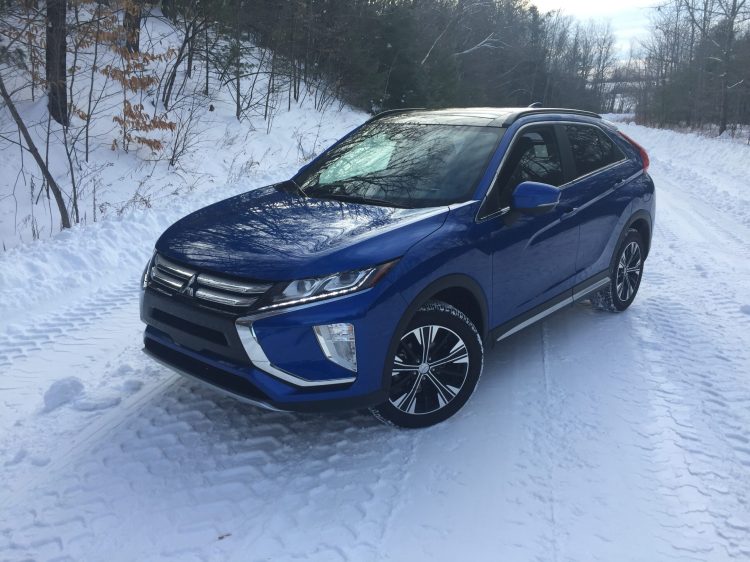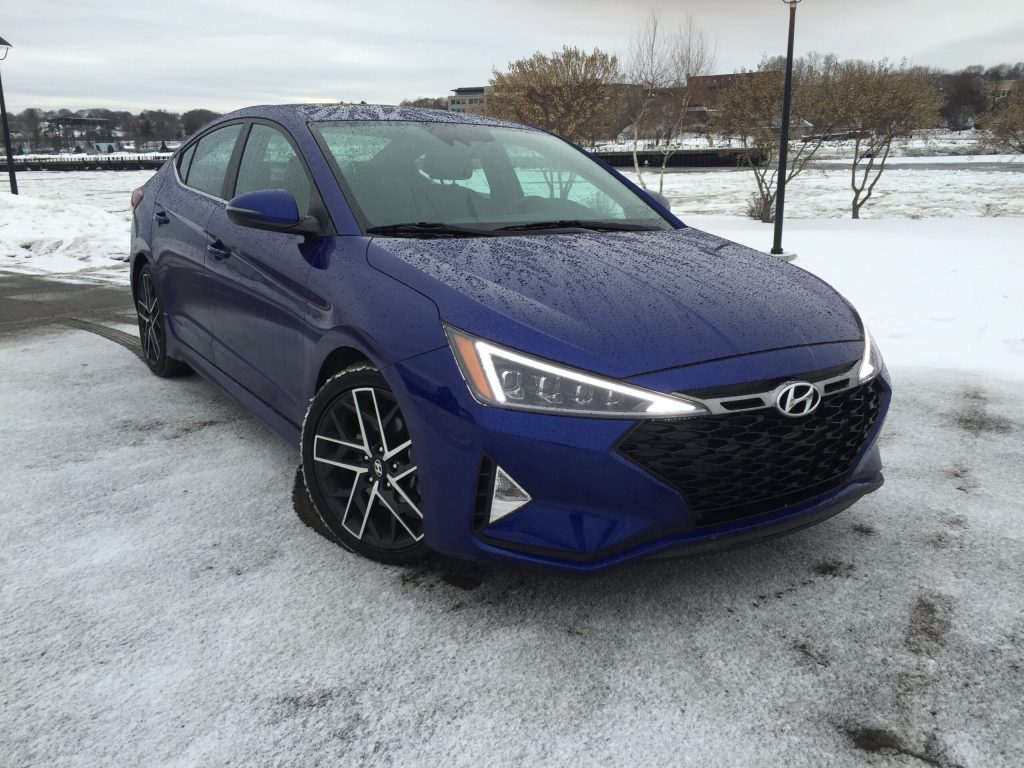The Mitsubishi Eclipse Cross is a rakish-looking small crossover available with front drive ($23,595) or lockable AWD like our top SEL trim, almost $31,000. Using a 1.5-liter turbocharged four-cylinder engine, the Eclipse Cross has spunky low-end power that progresses to more than adequate highway acceleration. The standard CVT automatic helps AWD models earn EPA ratings of 25/26-mpg; after 1,300 miles and four fill-ups, our actual mileage was a commendable 26.2-mpg with a lot of highway travel.
The coupe-like lines of the Eclipse Cross compromise the height of the rear cargo hold, however, rear seat passengers have ample room for two, even with dual sunroofs overhead adding extra ambient light. Wrap-around doors provide a clean and convenient threshold for easy entry and exit, while nicely heated leather seating kept winter’s chill at bay.
Vibrant in Octane Blue Metallic paint, our SEL trimmed Mitsu featured a Rockford-Fosgate HD audio system compatible with Apple/Android functionality as well as the best Sirius reception recently sampled, as well as adaptive cruise, heated steering wheel, forward collision assistance, lane departure warning, cross-traffic alerts, plus a pop-up heads-up display.
Cons; the Eclipse’s 7-inch touchscreen lacks any buttons or knobs, making the operator dependent on a very-distracting touch-pad on the console. The Mitsubishi’s ride seemed slightly less than compliant on many surfaces.
The Eclipse Cross is comparable in size to the front-drive Nissan Kicks, Kia Soul, and Toyota CH-R, as well as the Mazda CX-30, Kia Niro, Hyundai Kona, and the Subaru Crosstrek. The Mitsubishi’s optional AWD and wide assortment of features matches up well with the Korean offerings, however, the Subaru is the top seller in this pack—a car that costs less, has higher fuel economy ratings, plus AWD is standard.
Mitsubishi is at a crossroads in America. The recent Carlos Ghosn CEO scandal with its Nissan partner, plus a dearth of new products offerings, are both reflected in flat sales. The Eclipse Cross brings life to the brand, yet so much more is needed.
The new Hyundai Elantra Sport expands this compact sedan lineup with an energetic 201-hp 1.6-liter Turbo-motor harnessed to a 7-speed dual-clutch automatic with paddle shifters. Normally a sedate 4-door best utilized for efficient commuting, the turbo-motor adds another dimension to the Elantra’s personality, creating nimble and sporty rival to Honda’s Civic Si.
Equipped with low-profile tires on larger 18-inch wheels, attached to a multi-link sport-tuned suspension, along with the requisite dual-exhaust pipes out back, the Elantra Sport looks the part while delivering potent wheel-churning acceleration. Unfortunately, the same winding rural roads that aggravated the Eclipse Cross’ suspension were also covered with layers of winter sand and slippery slime that severely tested the grip of the less than winter capable tires found on the front-drive Elantra.
Recently redesigned, the Elantra is quite roomy. Sight lines are good, the cabin is ergonomically efficient, while content levels are consistently higher than similar products that come with higher price points. Base pricing is only $18,950, with our richly appointed Intense Blue Sport going for just $27,000. This includes an 8-inch info/entertainment screen with Apple/Android, navigation, XM radio, Blue-Link connectivity and multi-media support, power sunroof, heated leather seating (manual adjustments) plus the same wide-ranging electronic safety aids as the Mitsubishi. The Hyundai also features a flat-bottom steering wheel and dual-zone auto-climate controls.
The 1.6-liter Turbo-motor is shared with several other Hyundai/Kia models because it delivers the energetic power that target buyers seek. Thrifty when cruising, the Sport proved to be fun to drive, quick when requested, with nice tactile feel from the helm. The seat was all-day comfortable, the touch-points are excellent, and the optional navigation screen provides top-notch contrasts, destination access, and travel info. The Sport also met its 33-mpg EPA economy estimates over 800-miles.
It wasn’t that long ago that small cars lacked the features evident here; not only because buyers wanted inexpensive, but it didn’t make economic sense for the automakers. The proliferation of new, more powerful computer chips have accelerated access to electronic driving aids, creature features, and other safety gear that used to be found only in vehicles costing two or three times as much as this Elantra. If you have been out of the new car market for more than a few years, the Elantra Sport’s content level will be impressive.
This segment has dramatically changed. Chevy’s Cruze is gone. Ford’s Focus will exit soon. Chrysler’s last small car, the Dart, barely made it to first base. That leaves this Elantra to do battle with the Civic and Corolla. This Sport model, along with the regular sedan, and the Ioniq hybrid derivative, give Hyundai plenty of ammunition for a long, contested battle for compact car shoppers.
Send questions/comments to the editors.




